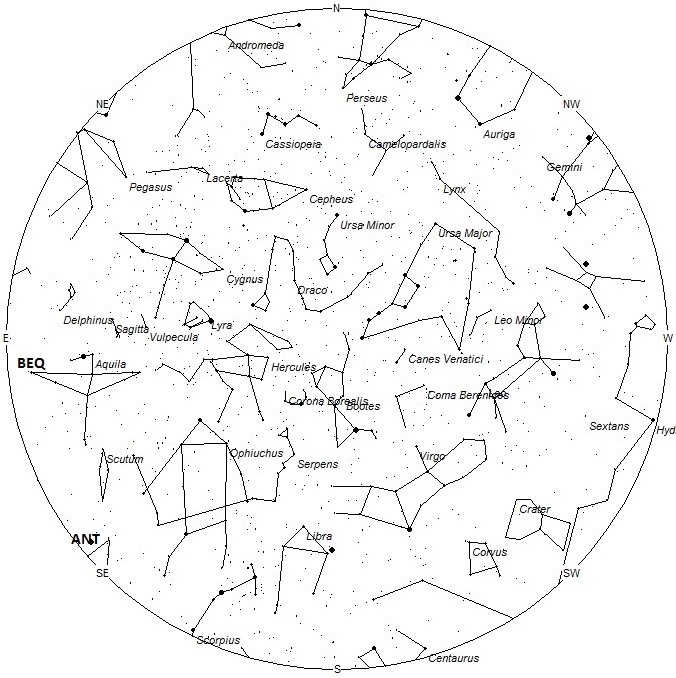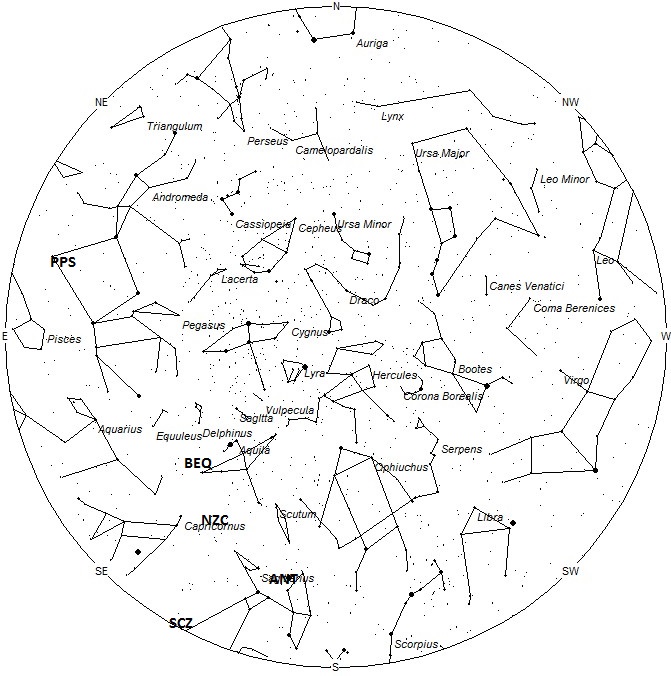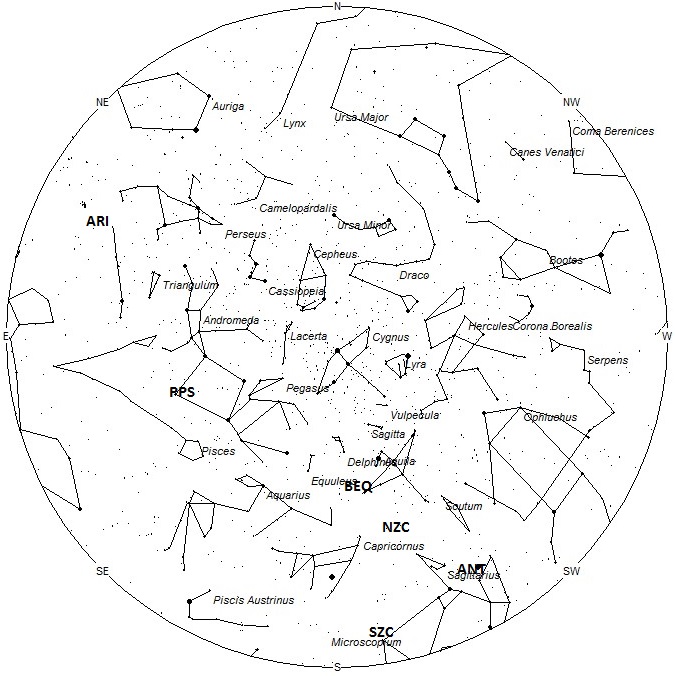
June, 21 2014 (Canon EOS 350D Digital, 30s, ISO1600, ƒ/1.8) © Hui Chieh
During this period the moon will reach it’s first quarter phase on Wednesday June 20th. At that time the moon will be located 90 degrees east of the sun and will set near 0100 local daylight saving time (LDT). This will cause interference with evening meteor viewing but the more active morning hours will be free of moonlight. This weekend the waxing crescent moon will set prior to midnight allowing good views of the morning activity. The estimated total hourly meteor rates for evening observers this week is 3 as seen from mid-northern latitude (45N) and 4 from the southern tropics (25S). For morning observers the estimated total hourly rates should be near 8 as seen from mid-northern latitudes (45N) and 11 from the southern tropics (25S). Evening rates are reduced due to interfering moonlight. The actual rates will also depend on factors such as personal light and motion perception, local weather conditions, alertness and experience in watching meteor activity. Note that the hourly rates listed below are estimates as viewed from dark sky sites away from urban light sources. Observers viewing from urban areas will see less activity as only the brighter meteors will be visible from such locations.
The radiant (the area of the sky where meteors appear to shoot from) positions and rates listed below are exact for Saturday night/Sunday morning June 16/17. These positions do not change greatly day to day so the listed coordinates may be used during this entire period. Most star atlases (available at science stores and planetariums) will provide maps with grid lines of the celestial coordinates so that you may find out exactly where these positions are located in the sky. A planisphere or computer planetarium program is also useful in showing the sky at any time of night on any date of the year. Activity from each radiant is best seen when it is positioned highest in the sky, either due north or south along the meridian, depending on your latitude. It must be remembered that meteor activity is rarely seen at the radiant position. Rather they shoot outwards from the radiant so it is best to center your field of view so that the radiant lies near the edge and not the center. Viewing there will allow you to easily trace the path of each meteor back to the radiant (if it is a shower member) or in another direction if it is a sporadic. Meteor activity is not seen from radiants that are located far below the horizon. The positions below are listed in a west to east manner in order of right ascension (celestial longitude). The positions listed first are located further west therefore are accessible earlier in the night while those listed further down the list rise later in the night.
These sources of meteoric activity are expected to be active this week.
The center of the large Anthelion (ANT) radiant is currently located at 18:32 (278) -23. This position lies central Sagittarius, just 1 degree southeast of the bright planet Saturn. Due to the large size of this radiant, Anthelion activity may also appear from Serpens Cauda and Scutum as well as Sagittarius. This radiant is best placed near 0200 local daylight saving time (LDT), when it lies on the meridian and is located highest in the sky. Hourly rates at this time should be near 2 as seen from mid-northern latitudes and 3 as seen from tropical southern latitudes. With an entry velocity of 30 km/sec., the average Anthelion meteor would be of slow velocity.
The Northern June Aquilids (NZC) may be seen this week from a radiant located at 19:40 (295) -10. This area of the sky is located in southern Aquila, directly between the 3rd magnitude stars known as Al Thalimain (lambda Aquilae) and Dabih (beta Capricornii). This radiant is best placed near 0300 LDT, when it lies on the meridian and is located highest in the sky. With the July 3rd maximum still 2 weeks away, hourly rates at this time will be less than 1 no matter your location. With an entry velocity of 38 km/sec., the average meteor from this source would be of medium-slow velocity.
The Southern June Aquilids (SZC) were discovered by G. Gartrell and W. G. Elford, in their study of Southern Hemisphere meteor streams. This stream is active from June 9 through July 17 with maximum activity occurring on July 6. The radiant is currently located at 19:58 (299) -33. This area of the sky is actually located in southeastern Sagittarius, 2 degrees north of the pair of faint stars known as theta Sagittarii. This radiant is best placed near 0300 LDT, when it lies on the meridian and is located highest in the sky. With the July 6th maximum still 2 weeks away, hourly rates at this time will be less than 1 no matter your location. Interestingly enough, the radar equipment operated by Dr. Peter Brown currently shows this stream as a strong source. This means it is producing a lot of faint meteors, most are below the threshold of normal vision. With an entry velocity of 39 km/sec., the average meteor from this source would be of medium-slow velocity.
The beta Equulids (BEQ) were discovered by Dr. Peter Brown and associates using data from the Canadian Meteor Orbit Radar (CMOR) installation. These meteors are active from June 7-30 with maximum activity occurring on June 14th. The radiant position currently lies at 20:16 (304) +01. This area of the sky lies in eastern Aquila, 2 degrees northeast of the 3rd magnitude star known as Tseen Foo (theta Aquilae). These meteors are best seen near during the last dark hour of the night when the radiant lies highest in a dark sky. Hourly rates are expected to be less than 1. With an entry velocity of 33 kilometers per second, a majority of these meteors will appear to move with medium-slow velocities.
The phi Piscids (PPS) are another discovery by Dr. Peter Brown and associates using data from the Canadian Meteor Orbit Radar (CMOR) installation. These meteors are active from June 8-August 02 with maximum activity occurring on July 5th. The radiant position currently lies at 00:08 (002) +18. This area of the sky lies in southeastern Pegasus, 2 degrees north of the 3rd magnitude star known as Algenib (gamma Pegasi). These meteors are best seen near during the last dark hour of the night when the radiant lies highest in a dark sky. Hourly rates are expected to be less than 1. With an entry velocity of 67 kilometers per second, a majority of these meteors will appear to move with swift velocities.
The last of the Daytime Arietids (ARI) will be seen this week. These meteors are active from May 22 through June 24 with a peak on June 7. The radiant is currently located at 03:32 (053) +26. This area of the sky is located on the Aries/Taurus border, 4 degrees northwest of the naked eye open cluster known as the Pleiades. The best time to view this activity is during the hour before the start of morning twilight, when the radiant lies highest in a dark sky. With the radiant low in the east it would be best to face halfway up in the sky in a northeast direction. With an entry velocity of 42 kilometers per second, these meteors will appear to move at a medium velocity.
As seen from the mid-northern hemisphere (45N) one would expect to see approximately 7 sporadic meteors per hour during the last hour before dawn as seen from rural observing sites. Evening rates would be near 2 per hour. As seen from the tropical southern latitudes (25S), morning rates would be near 9 per hour as seen from rural observing sites and 3 per hour during the evening hours. Locations between these two extremes would see activity between the listed figures. Evening rates during this period are reduced due to moonlight.
The list below offers the information from above in tabular form. Rates and positions are exact for Saturday night/Sunday morning except where noted in the shower descriptions.
| SHOWER | DATE OF MAXIMUM ACTIVITY | CELESTIAL POSITION | ENTRY VELOCITY | CULMINATION | HOURLY RATE | CLASS |
| RA (RA in Deg.) DEC | Km/Sec | Local Summer Time | North-South | |||
| Anthelion (ANT) | – | 18:32 (278) -23 | 30 | 02:00 | 2 – 3 | II |
| Northern June Aquilids (NZC) | Jul 03 | 19:40 (295) -10 | 38 | 03:00 | <1 – <1 | IV |
| Southern June Aquilids (SZC) | Jul 06 | 19:58 (299) -33 | 39 | 03:00 | <1 – <1 | IV |
| beta Equulids (BEQ) | Jun 14 | 20:16 (304) +01 | 33 | 03:00 | <1 – <1 | IV |
| phi Piscids (PPS) | Jul 05 | 00:08 (002) +18 | 67 | 07:00 | <1 – <1 | IV |
| Daytime Arietids (ARI) | Jun 07 | 03:32 (053) +26 | 41 | 11:00 | <1 – <1 | IV |







 You saw something bright and fast? Like a huge shooting star? Report it: it may be a fireball.
You saw something bright and fast? Like a huge shooting star? Report it: it may be a fireball.  You counted meteors last night? Share your results with us!
You counted meteors last night? Share your results with us!  You took a photo of a meteor or fireball? You have a screenshot of your cam? Share it with us!
You took a photo of a meteor or fireball? You have a screenshot of your cam? Share it with us!  You caught a meteor or fireball on video? Share your video with us!
You caught a meteor or fireball on video? Share your video with us!